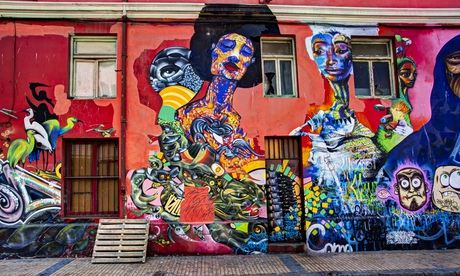As the sun sets, the houses that cover the city's many hillsides change tone, chameleon-like, from strong and vibrant to dusky shades of pink, gold, sage and pale blue. On the park lawn, a trapeze artist is balancing on a high wire in the last fingers of sunshine and two actors rehearse their lines under the violet blooms of a jacaranda tree. In the auditorium at the far side of the park, in a high-ceilinged room with wooden floors and long black curtains, a small audience settles in to listen to a series of international musicians taking part in an experimental gig. Welcome to Friday evening, Valparaíso-style.
Only two hours from the Chilean capital of Santiago, Valparaíso spreads across a series of hillsides that form a natural amphitheatre overlooking the sea. Where Santiago is all about business and government, Valparaíso is more laid-back. Its streets are still pleasingly ramshackle in parts and it has the vague seediness that often characterises large ports. Chilean artists, writers and musicians have long made the city their home, drawn to its picturesque location and bohemian mores – Nobel prize-winning poet Pablo Neruda is one notable former resident. With its artistic vibe and slightly crumbling feel, Valparaíso has an ambience akin to a smaller, seaside, Latin version of Berlin.
Add in a $73m investment programme – the city was listed as a Unesco world heritage centre in 2003, prompting a much-needed influx of government funds – and Valpo, as the locals refer to it, is transforming into Chile's most creative city. It's also a burgeoning tourist destination.
The city's former prison typifies its transformation. Formerly squatted by an art collective, it reopened in the summer of 2013 as a cultural centre, Parque Cultural de Valparaíso, with a public park and a new auditorium designed by HLPS, one of Chile's up-and-coming architecture practices. It's here I watch musicians and acrobats at sunset. But you don't need to venture to the highbrow performance centre to find music, culture and art. The real action takes place in the streets that cover the city's cerros (hills).
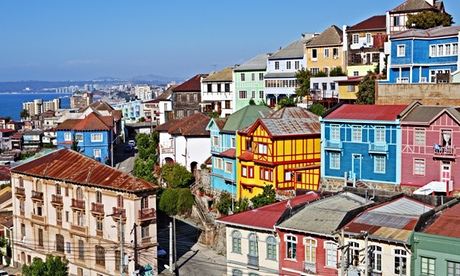 Colourful buildings on the hills of Valparaíso. Photograph: John W Banagan/Getty Images
Colourful buildings on the hills of Valparaíso. Photograph: John W Banagan/Getty Images
The most tourist-friendly of the hills are Cerro Alegre and Cerro Concepción. Twisting sharply upwards from the waterfront, these neighbouring barrios are home to galleries, restaurants, bars and hotels, all tucked away on quiet, cobbled streets lined with clapboard houses in kaleidoscopic colours. You can take a creaking funicular up the steepest slopes (the fare is 100 pesos, around 10p) or, if you walk, pause for breath on the climb and turn to see the pink, lemon, lime and ochre houses standing in contrast to the blue of the sky and deep indigo of the ocean.
Alegre is the hub of the growing gallery scene. Among the best is Casa E, run by Emilio Lamarca, a charming former diplomat from Santiago who left his government role five years ago and moved to Valparaíso to take a punt on a growing interest in modern Chilean art.
"Nobody else was focusing on contemporary Latin American art and I felt there was a real need for a gallery that shows the quality of the work we have on offer here," he says.
Today Casa E offers a varied programme of video pieces, installation art and photography, and runs an annual prize to promote the work of emerging artists.
Another gallery worth a look is Bahía Utópica, which specialises in prints by Loro Coirón, a French-born artist who has made his life in Valparaíso. Coirón's wood-block street scenes adorn the walls of local cafes and hotels and have an energy about them that is vividly redolent of a city whose grit and soul remain intact.
Much of the art produced here, like Coiron's, spills out on to the streets. Local artists use the city as their canvas and street artists from around the world come to create intricate works on the buildings of Cerro Alegre.
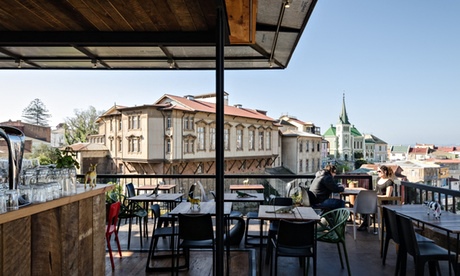 View of Valparaíso from the Hotel Fauna’s rooftop bar. Photograph: Pablo Blanco
View of Valparaíso from the Hotel Fauna’s rooftop bar. Photograph: Pablo Blanco
Local businesses embrace this creativity and the best street artists are paid for their work. At Hostal Acuarela – the name means watercolour – Ana from reception takes me outside and proudly displays a wall covered with an intricate, India-inspired pattern by a street artist called Mono Type.
"We bartered with him: he painted the wall for us and stayed with us for free while he was doing it," she says.
One of the best ways to appreciate all this public art is to take a tour with Valpo Street Art. Walks led by genial American expat Al – whose second job as a sommelier makes him a useful wine guide, too – take in the best pieces and, if you're in luck, give you a chance to meet the artists.
Many of the paintings are intricate and complex works that require time to prepare and execute – walls need to sealed before painting if the piece is to last – so many artists ask for permission from the wall's owner before beginning. "I'm meeting a German guy this afternoon who wants a couple of walls to work on," says Al. "I think I know some places that might work."
But Dave, an Australian artist, is dismissive of prepping and asking permission, muttering "pussies" under his breath when I mention it. "I like simple, graphic designs and I work fast. I don't mind if the work doesn't last – that's the nature of street art."
He promises to take me out to watch him work but then reveals that it's his birthday. So we wander to a bar to drink pisco sours and set the world to rights instead. As befits a city of artists, Valparaíso has no shortage of drinking opportunities. For a more refined ambience, stick to Concepción, where Bar de Pisco is the best place to try the local spirit and Fauna has a decent cocktail bar with a deck that makes the most of the sunset views over the city.
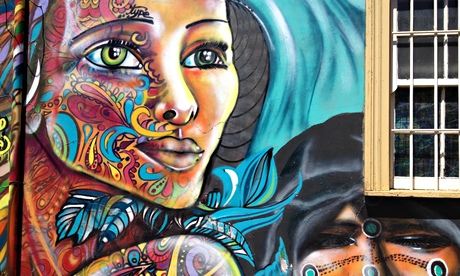 Mural on a building in Cerro Alegre.
Mural on a building in Cerro Alegre.
For a more local vibe, Bar Liberty on Plaza Echaurren is a great spot for lunch or a beer. It is a traditional Chilean drinking den, its clientele a mix of tradesmen, shopkeepers and artists. The row of hats lined up above the bar is testament to the drinking done here: if you fall asleep after one too many, the bar claims your hat as its own. Tourists are welcome enough, but are not fawned over, and you'll need to speak Spanish to order or chat.
Locals in the city can be aloof at first. There's a sense, among some, that development in Valparaiso is being driven by foreign investment. Drinkers at Bar Liberty shrug, ambivalent, when I ask them about the new-look Valpo. "Mostly it's foreigners who are making the money," says one.
Younger locals are more upbeat. Valpo has a large student population and if you sit in a cafe in student-friendly Concepción or neighbouring areas such as Panteón and Bellas Artes, you'll soon be chatting with locals sporting dreadlocks, piercings and tattoos, who'll be happy to share tips on which bars serve the best pisco and where to hear the latest band.
Local band La Smala is one worth checking out and, especially at weekends, you can find all kinds of live music in bars throughout the city, from Chilean folk and pop to Latin fusion. Try L Bar (General Cruz, 335) in El Almendral and the bars on Cumming at the base of Cerro Panteón.
When it comes to food to soak up all that pisco, Vinilo (+56 32 223 0665, cafevinilo.cl) is worth a visit for a contemporary take on Chilean dishes such as shredded beef in a stylish roulade. Or try Puerto Claro , further up the hill on the corner of Calle Galos, for home-cooked, traditional-style food in what was once a living room.
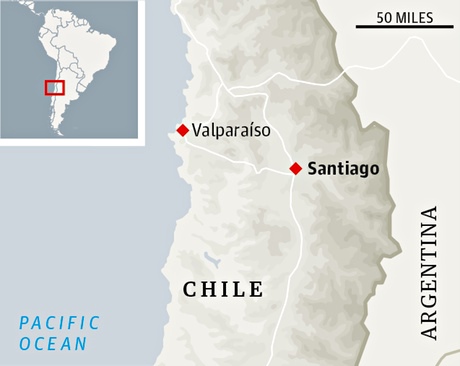
Valpo is waking up to its tourism potential and there are now plenty of places to stay that mirror the city's character. Fauna (doubles from $140) has striking views from its adobe-clad rooms, which also feature work by local artists. Next door, Via Via (doubles from around $71 B&B) is a great-value, art deco house that's been converted to an eco-friendly hotel by a Belgian couple. It has a lovely garden and a cafe serving Belgian specialities, such as mussels, as well as Chilean dishes.
There are cheaper options, too: the above-mentioned Hostal Acuarela (+56 32 318 0456, hostalacuarela.cl) has dorm beds from $19 and doubles from $45 – as well as a terrace with unsurpassable views. Or for a true taste of Valpo spirit, try Casa Verde Limón ( doubles from £12). The brightly painted bedrooms are scuffed and in need of a makeover, but in pride of place in the double-height living room is a trapeze that all guests are welcome to use.
Getting there
Flights were provided by Iberia, which flies from London Heathrow to Santiago via Madrid from £657 return, and from Manchester from £751 return. The bus from Santiago to Valparaíso costs £5 each way and takes 90 minutes
Further information
Chilean tourist board: joinchile.com
Four more arty places in Latin America
Paraty, Brazil
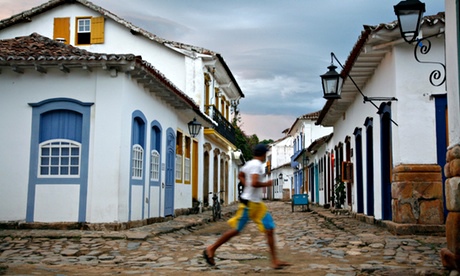 Colonial houses in the historic part of Paraty, in the state of Rio de Janeiro state, Brazil. Photograph: Alamy
Colonial houses in the historic part of Paraty, in the state of Rio de Janeiro state, Brazil. Photograph: Alamy
It's hard to find a more beautiful spot than Paraty, below: the colonial town sits between emerald-green hills and white-sand beaches. Its cobbled streets, lined with one-storey whitewashed buildings, attract a mix of backpackers, weekenders from Rio and the odd international celeb wafting through the boutiques, classy cafes and art galleries. Though you probably wouldn't find them tasting the wares in one of the town's six cachaça distilleries.
San Miguel de Allende, Mexico
Recently declared a Unesco world heritage site, San Miguel de Allende is known for its colonial architecture, shops and culture. Its compact centre is filled with narrow streets, cobbled alleys and homes painted in muted ochre colours. The city is home to a large population of artists and writers, both native and foreign, and hosts regular music, dance and literary festivals. There are plenty of studios, galleries and design stores and a vibrant food scene, with some of Mexico's best-known chefs opening restaurants in the city.
Cartagena, Colombia
Arguably Colombia's most beautiful city, Cartagena combines striking colonial architecture and a vibrant cultural life without sacrificing reality: streets are still buzzing with locals and you can find yourself spending longer than expected people-watching in a coffee shop or just sitting in a square admiring the orange and yellow houses. It is especially good for literature lovers, who can take a Gabriel García Maárquez tour (tourincartagena.com) of places mentioned in his novels; and the Hay literature festival holds an outpost event there each January.
León, Nicaragua
Unlike Granada, Nicaragua's other colonial-era city, León has avoided the ossification that sometimes results from reliance on tourism. Families still sit on rockers on the porches and play basketball in the streets. And, thanks to a large student population and a strong cultural legacy (two of the nation's poets, Rubén Darío and Alfonso Cortés, are from the city), León has a vibrant intellectual life. The former homes of both Darío and Cortés are now museums; Fundación Ortiz Gurdian showcases a wide selection of Nicaraguan and Latin American art; the city also has several beautifully renovated colonial-era churches. TL
